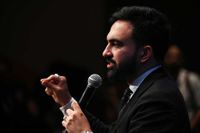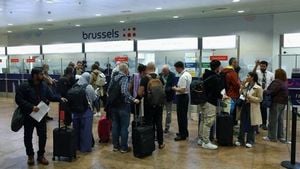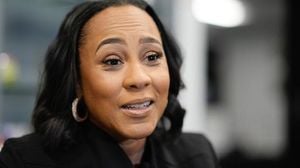With just under two months to go before New York City’s pivotal mayoral election, the city’s political landscape is buzzing with energy, intrigue, and a healthy dose of uncertainty. At the center of this storm stands Zohran Mamdani, the Democratic nominee whose rapid ascent has not only shaken up the race but also drawn national attention. Multiple new polls released in early September 2025 consistently show Mamdani holding a commanding lead over his rivals, with his campaign’s momentum fueled by both grassroots enthusiasm and a shifting political climate.
According to a fresh Emerson College/PIX11/The Hill poll conducted between September 7 and 8, Mamdani leads the crowded four-way field with 43% support among active city voters. Former Governor Andrew Cuomo, now running as an independent after his Democratic primary defeat, trails with 28%. Republican Curtis Sliwa and incumbent Mayor Eric Adams, who is seeking reelection as an independent, are far behind at 10% and 8%, respectively, while 9% of voters remain undecided. These numbers mirror findings from a recent New York Times/Siena College poll, which put Mamdani at 46%, Cuomo at 24%, Sliwa at 15%, and Adams at 9% (as reported by The Guardian and New York Times).
But what’s driving Mamdani’s surge? CNN’s chief data analyst Harry Enten offered a straightforward explanation: "The primary win may have been historic, but the reason he leads in the general election is not historic at all." Enten pointed out that New York City remains a deeply Democratic city—62% of all likely voters in November’s mayoral election voted for Kamala Harris in the 2024 presidential race, and a whopping 86% of Mamdani’s supporters also backed Harris. "He, simply put, is winning over Democrats, which in New York City is enough," Enten told CNN’s John Berman. Among Harris voters, Mamdani leads Cuomo by a staggering 64% to 25% margin.
Yet, Mamdani’s appeal is not universal. The NYT/Siena poll found he’s doing “slightly worse” with those who did not vote in 2024, and only 4% of Trump voters plan to support him this November. In districts that went for Trump last year, Mamdani won just 30%, trailing Sliwa, Cuomo, and Adams among those voters. Still, in a city where Democratic voters vastly outnumber Republican ones, Mamdani’s coalition remains formidable.
Age is another decisive factor. The Emerson poll shows Mamdani with a massive 29-point lead over Cuomo among voters under 50 (49% to 20%), though the race tightens among those over 50, with Mamdani ahead 39% to 33%. A UMass Lowell/YouGov poll released on September 10 backs this up, showing Mamdani leading Cuomo 55% to 6% among 18-29 year olds, 52% to 23% among 30-44 year olds, and 44% to 26% among 45-64 year olds. Cuomo only leads among voters over 65, 37% to 31%.
Beyond the numbers, Mamdani’s campaign is powered by a massive volunteer army—he told reporters at a Bronx news conference that his team is 60,000 strong and expects to reach 90,000 soon. "They are hungry for a politics that puts working people first," Mamdani said, reflecting on his campaign’s journey from just 1% in the polls to a historic primary win and now a significant general election lead.
Polls also indicate that Mamdani’s left-wing agenda resonates with many New Yorkers. The UMass Lowell/YouGov survey found 89% of respondents support building 200,000 new units of affordable housing, 78% back increasing the city’s minimum wage to $30 per hour by 2030, and 59% support congestion pricing. Perhaps unsurprisingly, 49% of voters believe Mamdani is best equipped to address the city’s affordability crisis, compared to just 24% for Cuomo.
Still, the race is not without drama. Reports from The New York Times and other outlets reveal that centrist leaders, business interests, and even the Trump administration are pressuring Adams and Sliwa to withdraw, hoping to consolidate the anti-Mamdani vote behind Cuomo. In a notable twist, Adams reportedly met with Trump’s Middle East envoy, Steve Witkoff, in Florida to discuss possible roles in a second Trump administration—positions that could include an ambassadorship or a post at the Department of Housing and Urban Development. Trump himself has publicly stated he does not want Mamdani, whom he labels “a communist,” to become mayor. Trump’s team has also reportedly dangled job offers to Sliwa, though the Republican nominee has declined.
What if Adams and Sliwa were to bow out? The NYT/Siena poll suggests the race would tighten considerably: Mamdani would lead Cuomo by just four points in a head-to-head matchup (48% to 44%). But for now, both Adams and Sliwa insist they’re staying in, with eight weeks to go until the November 4 election.
The city’s mood is one of change—and perhaps frustration. The UMass Lowell/YouGov poll found 73% of respondents disapprove of Adams’ job performance, and a striking 75% believe the country is on the wrong track. President Donald Trump’s approval rating is underwater in the city, with 72% disapproving and only 28% approving. Even Democratic leadership gets mixed reviews: 51% approve of Senator Chuck Schumer’s job performance, while 48% disapprove, and in a hypothetical 2028 Senate primary, Alexandria Ocasio-Cortez leads Schumer among Democratic voters, 46% to 35%.
As Mamdani’s campaign continues to gather steam, he’s not shying away from national progressive figures. This past weekend, he appeared alongside Senator Bernie Sanders at a Brooklyn town hall, signaling his intent to keep the city’s left-leaning base fired up through Election Day.
With a crowded field, restless electorate, and outside forces angling to shape the outcome, New York City’s mayoral race is shaping up to be one for the history books. But for now, the numbers—and the city’s mood—suggest that Zohran Mamdani’s message of change is resonating with voters eager for something different at City Hall.





